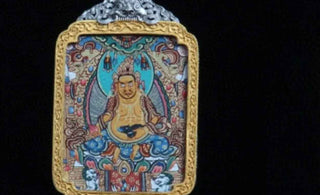
In the realm of spiritual guidance, Thangka art stands as a radiant beacon, illuminating the path of seekers with its intricate depictions and profound symbolism. The artistry and spiritual depth inherent in Thangka paintings offer a unique form of guidance, transcending the boundaries of time and culture to connect with the spiritual aspirations of individuals.
At the heart of Thangka art's role in spiritual guidance is its ability to visually narrate the sacred stories and teachings of Buddhism. Each Thangka unfolds a visual scripture, depicting scenes from the life of the Buddha, bodhisattvas, and other revered figures. The scenes are not mere representations but are imbued with layers of symbolism and meaning, guiding the viewer through the narrative of spiritual awakening.
Consider a Thangka portraying the life of Siddhartha Gautama, the historical Buddha. The artist, with meticulous detail, captures significant moments such as his birth, renunciation of worldly life, enlightenment under the Bodhi tree, and the preaching of the first sermon. Each scene serves as a guidepost along the spiritual journey, inviting the viewer to reflect on the profound teachings encapsulated in these pivotal moments.
Beyond narrative storytelling, Thangka art acts as a visual meditation tool. The intricate details demand focused attention, inviting the viewer to engage in contemplation. The meditative gaze upon the Thangka becomes a form of spiritual practice, facilitating a connection with the depicted figures and the underlying truths they represent. The act of gazing upon a Thangka becomes a transformative experience, guiding individuals into deeper states of reflection and introspection.
Moreover, Thangka paintings serve as sacred maps, illustrating the cosmic realms of Buddhist cosmology. Mandalas, a common theme in Thangkas, represent a symbolic universe, often centered around a deity. The geometric precision of mandalas guides practitioners in their meditative journeys, providing a visual framework for navigating the intricate landscapes of the mind and spirit.
In the contemporary context, Thangka art continues to play a vital role in guiding individuals on their spiritual quests. As seekers navigate the complexities of modern life, the timeless wisdom encapsulated in Thangka paintings offers solace and direction. The figures within the Thangka become spiritual companions, guiding practitioners through the challenges of existence with compassion and wisdom.
Consider a Thangka depicting Green Tara, the bodhisattva of compassion and protection. The visual guidance offered by Green Tara extends beyond the painted surface, becoming a source of inspiration for those seeking courage and solace.
The visual representation of Green Tara in Thangka art holds a profound significance that transcends the realms of mere aesthetics. Green Tara, a revered bodhisattva embodying compassion and protection, becomes a symbol of inspiration for those traversing the intricate pathways of life, seeking courage, and yearning for solace.
In the ethereal canvas of a Thangka, Green Tara is often depicted in a posture of grace and compassion, with one leg extended, ready to step down and offer immediate assistance to those in need. Her emerald-green complexion symbolizes the verdant landscape of compassion, and her eyes, filled with a benevolent gaze, exude a sense of maternal reassurance. Beyond the painted surface, this depiction serves as a visual testament to the compassionate nature of the bodhisattva, inviting the viewer to connect with the intrinsic qualities of empathy and protection.
The symbolism embedded in Green Tara's depiction serves as a guiding light for individuals navigating the complexities of life. The extended leg signifies her swift response to the calls of those in distress, emphasizing the immediate accessibility of compassion. In a world where challenges often seem insurmountable, the visual guidance of Green Tara becomes a source of inspiration, reminding seekers that compassion is not a distant ideal but a tangible and ever-present force.
The Thangka becomes a portal through which individuals can access the compassionate energy of Green Tara. The intentional selection of colors, symbols, and mudras in the painting amplifies the spiritual resonance, providing a visual language that communicates directly with the soul. As viewers engage with the Thangka, the benevolent energy of Green Tara becomes an immersive experience, offering solace and courage in the face of life's uncertainties.
The act of contemplating Green Tara in Thangka art transforms into a form of meditation. The intricate details invite a focused gaze, creating a sacred space for reflection. In this meditative encounter, individuals find not only an artistic representation but a living presence that speaks to the heart's yearning for compassion and protection. The visual guidance becomes an anchor, grounding seekers in the unwavering support of Green Tara.
Moreover, the symbolism of Green Tara extends beyond cultural and religious boundaries, resonating with individuals from diverse backgrounds. In a globalized world where people grapple with shared challenges, the visual guidance offered by Green Tara becomes a universal source of inspiration. The compassionate gaze of the bodhisattva becomes a unifying force, reminding humanity of the collective journey towards a more compassionate and interconnected world.
The depiction of Tara's graceful posture and compassionate gaze serves as a reminder that, even in the midst of challenges, the path of compassion and protection is ever-present.
In the process of creating or commissioning a Thangka, individuals actively engage in a form of spiritual practice. The intentional selection of deities, symbols, and colors becomes a conscious choice aligned with personal spiritual aspirations. This involvement in the creation process enhances the Thangka's role as a guide, as it becomes a visual manifestation of the practitioner's spiritual journey.
Through narrative storytelling, meditative engagement, and symbolic representation, Thangka art guides individuals on a path of self-discovery and spiritual awakening. As seekers gaze upon these sacred paintings, they find not only visual splendor but also a timeless source of inspiration and guidance for the intricate landscapes of the soul.
























